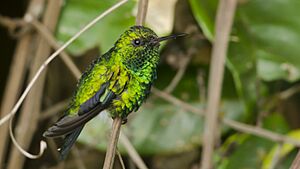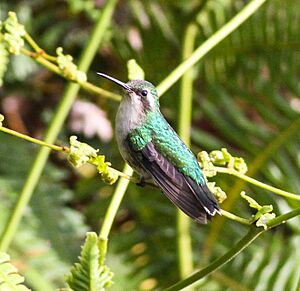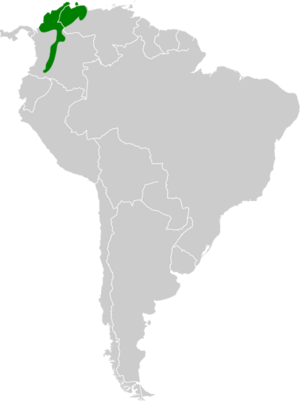Red-billed emerald facts for kids
Quick facts for kids Red-billed emerald |
|
|---|---|
 |
|
| Male | |
 |
|
| Female | |
| Conservation status | |
| Scientific classification | |
| Genus: |
Chlorostilbon
|
| Species: |
gibsoni
|
 |
|
| Distribution | |
| Synonyms | |
|
Chlorostilbon mellisugus gibsoni |
|
The red-billed emerald (Chlorostilbon gibsoni) is a tiny, colorful hummingbird found in parts of Colombia and Venezuela. It is known for its bright feathers and, as its name suggests, a bill that is partly red. This bird belongs to a group of hummingbirds often called "emeralds" because of their shiny green feathers.
About the Red-Billed Emerald
How Scientists Classify This Bird
Scientists group living things to understand them better. The red-billed emerald was first thought to be its own unique species. Later, some scientists believed it was a type of blue-tailed emerald.
However, since the early 2000s, most experts agree it is a separate species again. Sometimes, it was even thought to be the same as the western emerald.
Today, we know the red-billed emerald has three different types, called subspecies. These are C. g. gibsoni, C. g. chrysogaster, and C. g. nitens. They are all red-billed emeralds but have small differences.
What Does the Red-Billed Emerald Look Like?
This hummingbird is quite small, usually about 7.6 to 9 centimeters (3 to 3.5 inches) long. It weighs around 2.8 grams (0.1 ounces), which is less than a penny!
Males of all three types have a straight bill. Most of the lower part of their bill is red. Females also have some red at the base of their lower bill. The bill is about 1.3 centimeters (0.5 inches) long.
Male and Female Differences
Male red-billed emeralds of the main type (C. g. gibsoni) have dark bronze-green feathers on their upper body. Their tail is deeply forked and looks blue-black. Their face and belly are a sparkling green or golden-green.
Female red-billed emeralds of this type are shiny green on top. Their underparts are plain gray. They have dark cheeks and a short white line behind each eye. Their middle tail feathers are dark blue-green. The other tail feathers are dark green with dark ends and thin gray-white tips.
Differences in Subspecies
The C. g. chrysogaster subspecies is a bit larger than the other two. Its male is mostly a bright malachite green. Its tail is slightly bluer and more deeply forked than the others.
The C. g. nitens subspecies looks very similar to the main type. However, it has a slight gold shine to its feathers. Its tail is also not as deeply forked.
Where Do Red-Billed Emeralds Live?
The main type of red-billed emerald (C. g. gibsoni) lives in central Colombia. You can find it in the valley of the Magdalena River.
The C. g. chrysogaster subspecies lives in northern Colombia. It is found between the Córdoba and Norte de Santander areas.
The C. g. nitens subspecies lives on Colombia's Guajira Peninsula. It also lives in the nearby northwestern part of Venezuela.
These hummingbirds prefer dry or very dry places. They live in desert scrublands, dry woodlands, and even in farms, parks, and gardens. In Colombia, they are usually found below 500 meters (1,600 feet) in elevation. But they can live as high as 2,300 meters (7,500 feet) in the upper Magdalena valley. In Venezuela, they have been seen up to 1,300 meters (4,300 feet) high.
Red-Billed Emerald Behavior
How They Move Around
Scientists are not completely sure about the movements of the red-billed emerald. However, in some parts of northern Colombia, they seem to move to different areas depending on the season.
What Do They Eat?
The red-billed emerald mostly eats nectar from flowers. It flies from flower to flower along a regular path, like following a route. This is called "trap-lining."
They usually feed on small flowers close to the ground. These flowers might not attract bigger hummingbirds. Scientists believe they also eat small insects, which gives them protein.
Reproduction and Life Cycle
The breeding times for the red-billed emerald are not fully known. In Venezuela, they seem to breed from March to August. In at least one part of Colombia, they also breed in November.
One nest found was a soft, cup-shaped nest. It had lichen on the outside and was attached to a fern leaf.
How They Communicate (Vocalization)
The song of the red-billed emerald is a continuous series of high-pitched, trilled notes. It sounds like "wirrr...wirrr...wirrr..."
They also make other calls. These include a high-pitched, sharp "tseeee" sound. They also make a reedy "tzreee" call.
Status of the Red-Billed Emerald
The IUCN (International Union for Conservation of Nature) has looked at the red-billed emerald. They have assessed it as a species of "Least Concern." This means it is not currently in danger of disappearing.
We do not know the exact number of these birds or if their population is growing or shrinking. They are considered uncommon in the areas where they live. However, their dry habitat is not used much by humans. This means human activities probably do not threaten them.


